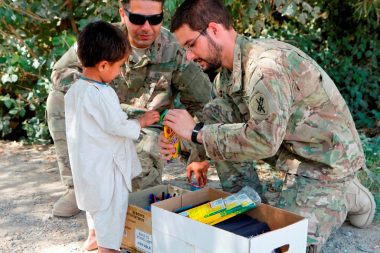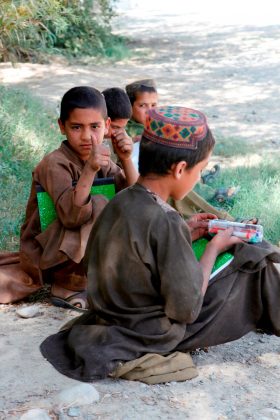James Black '09 contacted his alma mater in August 2011 with an idea. Several months later he describes the impact of Elon's drive for Afghanistan.
Black also has been selected for Elon’s 2012 Top 10 Under 10 Awards, which recognize outstanding young alumni.
*****
By James Black ’09

PHOTO GALLERY of AFGHAN CHILDREN RECEIVING SCHOOL SUPPLIES
I’m currently deployed to Afghanistan where I’ve witnessed seemingly endless violence, suffering and poverty. But in the fall of 2011 I also witnessed the power of Elon University and its impact on education in Afghanistan. Despite current domestic economic concerns, the Elon community came together to donate many hundreds of pounds of school supplies – and in doing so made a positive impact on the lives of hundreds of Afghan children.
Americans are predominantly free; free to enjoy basic infrastructure like electricity and access to clean drinking water, free to express contrarian thoughts, and free to pursue an education in a nation with an estimated 99 percent literacy rate. By contrast, Sangin, Afghanistan has a paltry 7 percent literacy rate.
Sangin District in Helmand Province is one of the most threadbare and war-torn regions in Afghanistan. Known as a Taliban stronghold, nearly one-third of all British killed and wounded have come from this small district since their entry into the war in 2001. I’ve spent the majority of my time supporting the 1st Battalion, 5th Marine Regiment from Camp Pendleton in California. Sangin was a hard fought battle for the Marines of 1/5. Seventeen Marines were killed and more than 150 were wounded during their seven month mission to rid Sangin of the insurgency.

For nearly two decades, the Taliban have actively oppressed the people of Afghanistan. Women had no say and were considered to be their husband’s property. In rural regions of Afghanistan, like Sangin, this blatant discrimination continues today. Opium poppy is grown in place of food crops because Taliban are known to intimidate locals and burn grain fields; illegally levied taxes on opium gum yield more revenue than taxes on food. Insurgents favor intimidation tactics that wreak havoc on infrastructure grids because it creates an environment in which Afghans are subjected to feelings of powerlessness and insecurity. Even if locals are fortunate enough to have electrical lines, they have almost no access to the power needed to run pumps for drinking water. Sewage runs through the streets.
Taliban and insurgent factions wage a war of indiscriminate hatred. The most prolific insurgent weapon in Sangin is improvised explosive devices. IEDs in Sangin are predominantly triggered by body weight and present a mortal threat to everyone. This means Afghan men, women and children live in constant fear of falling victim to a hidden bomb – and many do become victims, dying in horrific violence.
If lucky enough to avoid IEDs, Afghans still fall victim to the insurgent’s terror. Beatings and murders are commonplace, especially for those who resist the insurgency or dare to support the legitimate Government of the Islamic Republic of Afghanistan. Shopping for food in a town bazaar has, on occasion, been viewed by Taliban as support of GIRoA. Imagine being mercilessly beaten by thugs for getting groceries for your family.
One of the most effective ways insurgents oppress Afghans is through restriction of education. Education breeds free thought, desires of a better life, and the knowledge of what greater future could be found outside of a Taliban Afghanistan. To placate Afghans, Taliban and insurgent factions continue to intimidate good teachers, beat parents for allowing children attending schools, and force religious leaders to teach a bastardized Islam in which violence supplants peace. In some instances, receiving no education is better than being subjected to twisted ideologies.

The insurgency is not popularly supported – support comes through radical zealots and local Afghans intimidated through fear into compliance. As Coalition Forces systematically engage and remove insurgents from the battlefield, the remaining insurgency increases their attacks in an effort to reclaim lost human terrain and physical topography. Marines have guns, insurgents have shovels and bombs. Violence begets violence.
So how does Elon University fit into this? After graduating in 2009, I saw military service as a means to expand my horizons during economic uncertainty. I volunteered to deploy to Afghanistan, and in February of 2011 my detachment flew to Helmand Province to conduct psychological warfare. Psychological operations are planned operations to convey selected information and indicators to foreign audiences to influence their emotions, motives, objective reasoning and, ultimately, their behavior. Through behavior modification, I work to convince insurgents to lay down their arms and for all Afghans to become more engaged in building a better future for Afghanistan.
In July and August of 2011, the Marines and Sailors of 1/5 saw an increase in violence as insurgents attempted to regain their hold on Sangin. As 1/5 continued to repel their attempts, I saw an opportunity to fill the educational void, but supply channels can be reluctant to apply resources to an area that appears unstable. Marines began to find pockets of education, small schools hidden in private citizen’s housing compounds. But Sangin is a poor district, with the majority of earned income going to basic living expenses; funding a luxury like education is near the bottom of the list. Afghan teachers were willing to risk their safety to educate local youth, but effectively teaching without supplies is nearly impossible. And how do you promote education when resources are so limited? In August 2011 I reached out for help to an institution dedicated to service, global learning, and to assisting those in need throughout the world – Elon University.

Elon responded. In possibly one of the fastest community mobilizations I’ve ever seen, Elon came together as a community, proposed a plan to collect school supplies for both Sangin and Alamance County schools, and implemented their plan as students began returning for the start of a new academic year. Within a month I received nearly 1,000 pounds worth from Elon faculty & staff, students, alumni and private donors – enough to require two helicopter flights to deliver it.
It can be hard to resist the urge to personally distribute development aid. Americans handing out supplies or taking up the education reins is counterproductive to the desired end state of Afghan independence. After being in Afghanistan for a decade, the responsibility of governance and support falls on GIRoA. And while GIRoA struggles to become stronger, it is also my job to support the popular perception of GIRoA’s capability to meet the needs of the people. Afghans need to have faith in their government or the insurgency will continue. No amount of guns or bombs will completely solve this problem; the final step is for Afghans to take ownership of their future and deny the insurgency.
To fill the void while maintaining an appearance of GIRoA strength, I routed the school supplies through Afghan officials for public delivery. I collected information on local schools with solid education plans and organized quantities of supplies necessary to sustain an approximate year’s worth of teaching. Bundles of supplies were then distributed throughout the region for pending distribution. Typically this was through distributing the supplies through a community meeting (shura), at which Afghan officials presented the children and teachers with the donated supplies. Other military and aid organizations complemented Elon donations with Pashtu educational books and backpacks.
By the end of September, Marines organized supplies into distribution bundles with an expected reach of more than 200 children. On one occasion I supplemented a youth shura with a token amount of supplies and a speech intended to increase the desire to attend local schools. The children reacted to the simple school supplies as American children would react to Christmas in July; “excited” doesn’t begin to cover their surprise and ecstatic reactions. Most of these children had never seen the kinds of supplies Elon donated, nor have they felt encouraged to express themselves. Afghan children left the shura giddy, clutching pens, markers, colored pencils and paper as if they’d never let go of them.
In early October 2011 I relocated to a different province for operational reasons and to this day I continue to receive success updates from Marines in Sangin. In November 2011, a donkey carried Elon supplies to a remote school for distribution in conjunction with GIRoA and a Marine Civil Affairs detachment. The Elon Community’s generosity continues to make a positive impact on the quality of education offered in Sangin.
As Americans face an economic struggle, we are grateful for what we have. As we pass the decade milestone of war in Afghanistan, remember that our involvement here is not about instilling American culture – it is about providing Afghans with the tools to build a better future. I thank the Elon community for making a difference, not only to needy children in a war torn country, but to the service members whose efforts benefit from your support.


